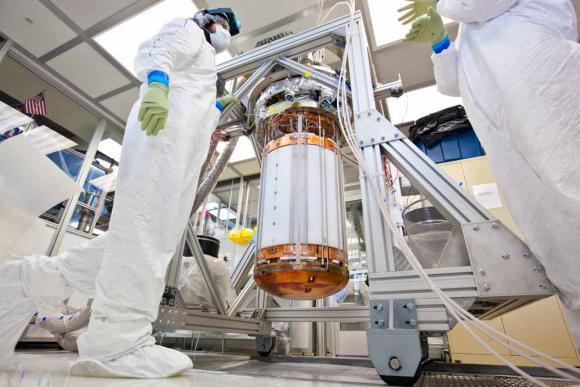PROVIDENCE, R.I. [Brown University] —The Department of Energy and the National Science Foundation announced support last week for several next-generation experiments in the search for dark matter. Among those getting the green light is the LUX-ZEPLIN (LZ) experiment, which includes a team of Brown University physicists and students.
LZ is an international collaboration formed in 2012, managed by DOE’s Lawrence Berkeley National Lab, and to be located at the Sanford Underground Research Facility (SURF) in South Dakota. The experiment will build on the work of the Large Underground Xenon (LUX) experiment, which is currently operating at SURF, and the ZEPLIN experiment, a U.K.-based detector.
Rick Gaitskell, Hazard Professor of Physics at Brown, is a founding member of LZ and also co-spokesperson for the LUX experiment.
“The go-ahead from DOE and NSF is a major event,” Gaitskell said. “The LZ experiment will continue the liquid xenon direct dark matter search program at Sanford Lab which we started with the operation of LUX in 2013. LUX will run until 2016 when we will replace it with LZ, which can provide a further improvement in sensitivity of two orders of magnitude due to its significant increase in size.”
Dark matter is a mysterious substance thought to account for about 80 percent of the mass in the universe. It’s impossible to see, however, because it doesn’t emit or absorb light. Scientists know it’s there because of its gravity, which influences the rotation of galaxies and bends the light emitted from distant objects in the universe. The leading model for what dark matter might be made of is the WIMP, short for weakly interacting massive particle. WIMPs are thought to interact so rarely with conventional matter that they constantly pass right through the Earth and everything on it, leaving nary a trace.
The LUX detector consists of a one-third-ton tub of supercooled liquid xenon festooned with powerful sensors. The device is designed to detect the tiny flash of light created on those ultra-rare occasions when a WIMP bumps into the nucleus of a xenon atom. To shield the detector from cosmic rays and radiation that could interfere with the WIMP signal, LUX is located a mile underground in a former gold mine and submerged in 72,000 gallons of deionized water. During its initial run last fall, LUX eliminated a vast swath of possible models WIMP models, and continues to help scientists close in on the elusive particles.
The next-generation detector, LZ, will consist of a 7-ton liquid xenon target and an active system for suppressing the rate of non-WIMP signals generated by background events, both located inside the same water tank used by LUX. The supersized detector will be more than 100 times more sensitive than the LUX is today.
“When completed, the LZ experiment will be the world’s most sensitive experiment for WIMPs over a large range of WIMP masses,” says Harry Nelson, physicist at the University of California, Santa Barbara and current spokesperson of the LZ Collaboration.
Even if LUX makes a dark matter detection before LZ is up and running, LZ will still be necessary to confirm the detection and fully characterize the nature of WIMPS, Gaitskell says.
“The two experiments are timed so that one will take over the other just when it reaches the limit of its technology,” says Simon Fiorucci, a research scientist at Brown who is the science coordinator for LUX and simulations coordinator for LZ. “It will be a natural transition regardless of the nature of the final result from LUX.”
The international LZ collaboration includes scientists and engineers from 29 institutions in the United States, Portugal, Russia and the United Kingdom.
“The great news is we’ve been given the go-ahead,” says William Edwards, LZ project manager and engineer in Berkeley Lab Physics Division. “We’re looking forward to making what has been a proposal into a real, operational, first-rate experiment.”

